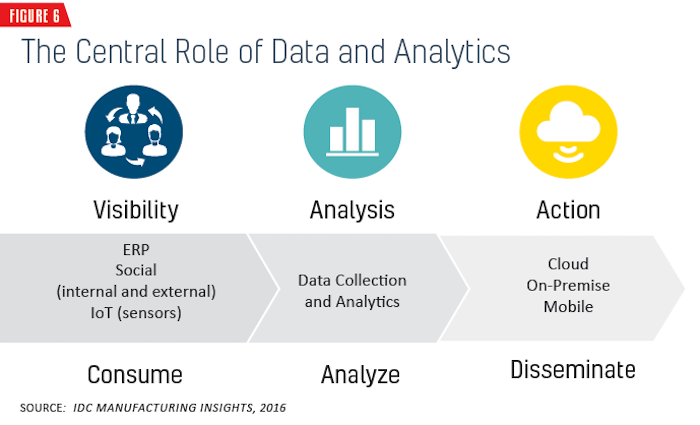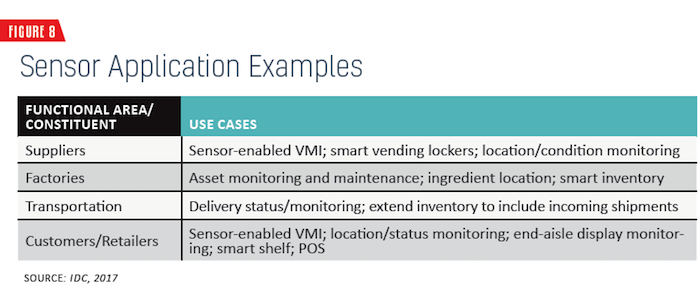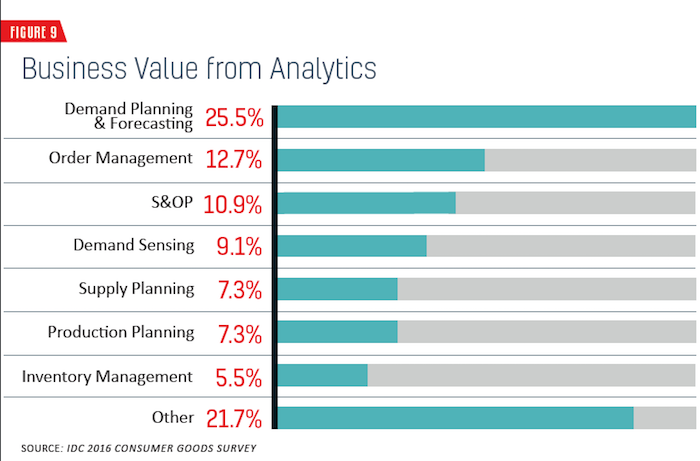Sales & Marketing Report 2017: What to Do with Data
The topic of downstream data is one we’ve covered in this report from the beginning, and we’ll continue to do so because it’s critical to the way that consumer goods manufacturers calibrate their business to demand. This year, though, we’d like to broaden the discussion to include all types of data. In a control tower report published earlier this year, IDC proposed an approach by which new technologies might “interact.” We present that here in Figure 6.

The idea is that data is collected from multiple sources (ERP, social and IoT), analyzed quickly, and then made available to the business via on-premise, cloud or mobile. The reality is that, regardless of the source or type, the data must be quickly analyzed and disseminated to the decision-makers within the business for it to be useful.
For example, many of the people I speak with think of the IoT as an “instrumentation problem” and while that may be true to a degree in 2017, the reality is that it’s really a “data and analytics problem.” You can capture all the sensor data in the world, but if accurate data quality and comprehensive analytics are absent, it’s not going to be useful.
The reality is that the improved collection and analysis of disparate data sources is likely to be the single largest driver of differential performance among consumer goods companies across all functional areas. Whether it’s input into or sources of innovation or demand data to drive supply chain forecast or responsiveness capabilities, the enterprise that consumes data more efficiently and effectively has a leg up on the competition. But it’s not just about the data, it’s also about the analytics capabilities.
When we speak with consumer goods companies, the growth in data volume and velocity is not lost on them — they get it. The challenge that they articulate is how to ensure that the analytics capabilities keep pace. Turning “data into insights” is the trick, so an “analytics gap” is the real problem, as illustrated in Figure 7. Yes, consumer goods companies are investing in analytics, and they are getting value from these analytics. But are the analytics keeping up with the growth in data?

In Figure 7, we also illustrate three main sources of data: the more traditional source, which is ERP, and then two emerging areas of social media/sentiment and the IoT (sensors). While ERP data is projected to increase modestly over time, social and particularly sensor data is projected to grow exponentially. Whether the conference-favorite “smart” refrigerator ever comes to be in a material way remains to be seen, but the instrumentation of the supply chain, for example, is moving forward full bore. Some potential sensor application examples are listed in Figure 8.

The examples listed in Figure 8 are all supply chain-centric, but that is where we see most IoT applications initially. However, it can be transformative in the sense that data is now (or is about to be) available to the supply chain and broader business where it was only speculation before. In last year’s report, we presented results from our 2016 supply chain survey identifying where companies are finding value from analytics capabilities. We represent that information in Figure 9.

Overwhelmingly, demand planning and forecasting is the top answer when it comes to getting value from analytics. So having comprehensive data, analyzed in real or near-real time, drives significant value for both the supply chain and the overall consumer goods enterprise.
Yet not all data is available in real time — nor needs to be, frankly. It is our estimate that about half of all consumer goods companies get 50% of their data in real time, with about one-fifth getting 75% or more in real time. This number will go up dramatically in the next few years as sensor data begins to contribute to overall data volume.
Lastly, we’d like to comment on data quality. As consumer goods companies move into the “data age,” the necessity for data quality grows. It will be very easy to go from “garbage in, garbage out” to “BIG garbage in, BIG garbage out.” Since many companies have struggled for years with data accuracy and quality, it suggests that this is something to be wary of lest CGs find themselves making bad data-driven decisions.
_____________________________________________
To read the rest of the report, click on the links below:
- Sales & Marketing Report 2017: Editor's Note
- The Progress Report
- The Evolving Role of TPM
- What to Do with Data
- Is DTC the Future — or the Present?
- Taking the Risk Out of Digitization
- Building a Smart Digital Enterprise
To download the full report, click here.

